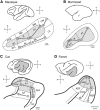Neural mechanisms for the abstraction and use of pitch information in auditory cortex
- PMID: 23015423
- PMCID: PMC3752151
- DOI: 10.1523/JNEUROSCI.3814-12.2012
Neural mechanisms for the abstraction and use of pitch information in auditory cortex
Abstract
Experiments in animals have provided an important complement to human studies of pitch perception by revealing how the activity of individual neurons represents harmonic complex and periodic sounds. Such studies have shown that the acoustical parameters associated with pitch are represented by the spiking responses of neurons in A1 (primary auditory cortex) and various higher auditory cortical fields. The responses of these neurons are also modulated by the timbre of sounds. In marmosets, a distinct region on the low-frequency border of primary and non-primary auditory cortex may provide pitch tuning that generalizes across timbre classes.
Figures

References
-
- Bizley JK, Nodal FR, Nelken I, King AJ. Functional organization of ferret auditory cortex. Cereb Cortex. 2005;15:1637–1653. - PubMed
Publication types
MeSH terms
Grants and funding
LinkOut - more resources
Full Text Sources
